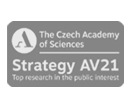Molecular beams experiments at the Heyrovský Institute aim to change the way the aerosol research is done
Prague, 15. 2. 2023
Aerosols have a significant impact on weather, global warming, human health, and chemistry in the atmosphere. However, the small nanometer-size aerosol particles are difficult to study in nature. They have been investigated at the J. Heyrovsky Institute of Physical Chemistry of the CAS, in the unique CLUB apparatus using molecular beams. This opens a new approach to the investigation of atmospheric aerosols, and the experiments can deliver some parameters for atmospheric models to make them more accurate.
Mixtures of solid or liquid particles in a gas, such as smoke, fog or haze - or aerosols - are responsible for a number of important processes in the atmosphere, from global warming and ozone depletion to reduced visibility and premature deaths in polluted areas. Although considerable research attention has been paid to their properties and behaviour in the atmosphere, they are still not well understood, which may affect, for example, the accuracy of climate models.
Scientists from the J. Heyrovsky Institute of Physical Chemistry of the Czech Academy of Sciences (JHI) study clusters (conglomerates of hundreds of molecules corresponding to nanometer-size particles) using the CLUB (CLUster Beam apparatus) in molecular beams, where the clusters fly isolated in a vacuum, and various experiments performed with them. In this way, they researchers can investigate at a detailed molecular level how individual molecules combine into clusters, how the molecules in the clusters react with each other, or what processes occur upon interactions with photons or electrons.
Experiments can refine atmospheric model parameters
In one experiment, researchers studied how various atmospheric molecules, particularly so-called volatile organic compounds (VOC) and their oxidized analogues, are adsorbed on clusters of hydrated acid. The experiments showed that after oxidation, the uptake probability for a VOC molecule is more ten times lower than for its oxidized analogue. VOCs and oxidation are known to play an important role in the formation of aerosols in the atmosphere. These experiments draw a molecular-level picture of the responsible processes.
"At the same time, we were able to dope clusters of hydrated acid with two different base molecules - dimethylamine and ammonia - in succession and to follow the detailed course of acid-base reactions in these clusters at the molecular level. Analogous reactions take place in atmospheric aerosols," says Michal Fárník, author of the study from the J. Heyrovsky Institute of Physical Chemistry of the CAS.
The Perspective article was published in The Journal of Physical Chemistry Letters.
A new way to study aerosols - neither in a computer nor in the atmosphere
In the field of aerosol research, analysis using molecular beams is not widespread. Field measurements directly in the atmosphere investigate rather larger aerosols, while computational techniques are used to study small clusters composed of a few (tens of) molecules, while leaving a gap around 1-10 nm particle size range. Laboratory cloud-chamber experiments common in aerosol research are closing this gap. However, individual clusters in this size range can be studied in details by molecular beam experiments. Thus, the researchers at the JHI hope that their experiment can bring a new dimension to the aerosol research.
"We are trying to show that this relatively challenging experiment can provide similarly detailed insight into aerosols as the theoretical calculations commonly used in this field. Molecular beam experiments thus represent a bridge between theoretical chemistry and the study of aerosols directly in the atmosphere," adds Michal Fárník.
The CLUB instrument for studying clusters of molecules is unique in the world
In the CLUB instrument, which is used to study clusters using molecular beams, gas issues through a small opening into a vacuum chamber. As molecules pass through the nozzle, they tend to join together to form clusters. In the vacuum, the clusters are then stable, fly along a straight beam path, and can be investigated by further experiments. Scientists from the JHI are currently able to create clusters that are close in composition and size to real atmospheric aerosols.
CLUB was originally built at the Max Planck Institute in Göttingen, Germany, where Michal Fárník worked on it during his postdoctoral stay and from where he brought it to Prague in 2005. A new experimental group was formed around the instrument at the JHI, which modified and extended the instrument with new experiments. The CLUB is unique in that several different experiments with clusters can be performed on it simultaneously in a single molecular beam, allowing direct comparison of the results of several different experiments.



















